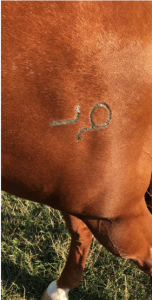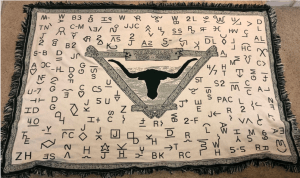Title: Cattle Brand
General Information about Item:
- Material Lore: Cattle Brand
- Language: English
- Country of Origin: United States
- Informant: Tyler Bowen
- Date Collected: May 20, 2019
Informant Data:
- Tyler was born and raised in Omaha, Nebraska; he is currently a sophomore at Dartmouth College studying economics. His family has a rich history of farming and ranching; his dad’s parents live on a cattle ranch in southeastern Kansas and his mother’s parents operate their family farm in central South Dakota which has been in their family for over 100 years. He grew up visiting both farms often and knows quite a bit about farming and ranching practices.
Contextual Data:
- Social Context
- Tyler first encountered cattle brands at his grandparent’s ranch in Kansas as a child, where his grandparents have a unique brand registered to the Bowen Ranch. When he was 12, he helped his grandfather brand some of their new cattle.
- Cattle are generally branded early in their lives or after being brought to a new ranch after being purchased at a livestock auction. Dark colored cattle are usually branded with a freeze iron, which is a metal iron dipped in liquid nitrogen. The iron is pressed against the cow’s hip and leaves a white mark which stays on the cow permanently. Light colored cattle are branded with a hot iron, leaving a dark brand on the cow’s skin permanently.
- Cultural Context
- Cattle branding dates back to the days of the Wild West, when cattle were turned loose on the plains to graze. Cattle belonging to different ranchers would intermix, and ranchers needed a way to tell their cattle apart during roundups. Brands are also used as a deterrent against cattle rustlers (thieves), as branded cattle can only be sold by the rancher who the brand is registered to.
Item
- The first item is the brand belonging to the Bowen Ranch, seen here as a freeze brand on one of the ranch’s horses (horses can also be branded, though cattle are the primary recipients of such marks). The Bowen Ranch’s brand is derived from the first two letters in the Arabic word for “farm” (muzrah), written in Arabic as مزرعة. Tyler’s grandfather, Bill Bowen, chose the word muzrah as inspiration for his brand because him and his wife Cheryl began the ranch raising Arabian horses, one of which they still have today.
- The second item is a blanket from the 100th anniversary of the town of Reliance, South Dakota which features all of the brands from farmers and ranchers used during the period of 1905-2005. Tyler’s great-great-grandfather Anton Straka’s brand is shown above the cow’s left horn on the blanket as , a stylized abbreviation of Anton’s name. The brand is no longer in use as Tyler’s family no longer runs their own cattle on the farm but instead rents it out to neighboring ranchers. This item represents the individual and communal aspects of cattle brands; each brand represents the identity and assets (cattle) of an individual rancher while the collection of brands symbolizes a community rooted in agriculture.
Associated Files:
Collector’s name: Tyler Bowen (collector and informant)



Unfortunately, the Cultural Context is completely incorrect. The Spanish brought branding into the New World as they were the first to introduce cattle into the Americas. Cattle branding in the New World was a requirement of the Spanish Crown and was practiced in Spain before the laws were enacted in New Spain (including today’s United States of America). The oldest known brands belonged to Fernando de León (1838), Simón Gonzales (1839), Cesario Garza (1850), and Plácido Benavides (1852).